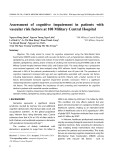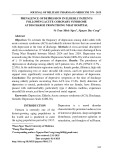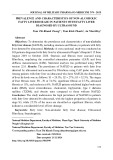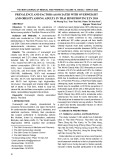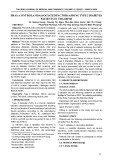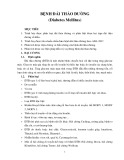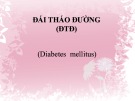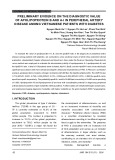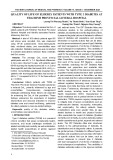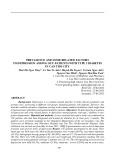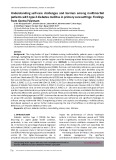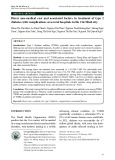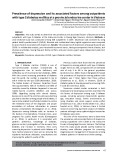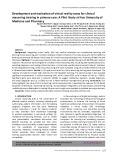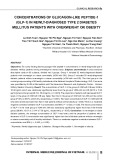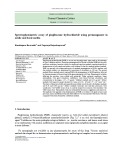
HUE JOURNAL OF MEDICINE AND PHARMACY ISSN 3030-4318; eISSN: 3030-4326
16
Hue Journal of Medicine and Pharmacy, Volume 14, No.6/2024
Understanding self-care challenges and barriers among multimorbid
patients with type 2 diabetes mellitus in primary care settings: Findings
from Central Vietnam
Le Ho Thi Quynh Anh1,2, Anselme Derese2, Johan Wens3, Wim Peersman4,5, Peter Pype2,
Jo Goedhuys6, Nguyen Vu Quoc Huy7, Nguyen Minh Tam1*
(1) Family Medicine Center, Hue University of Medicine and Pharmacy, Hue University
(2) Department of Public Health and Primary Care, Faculty of Medicine and Health Sciences,
Ghent University, Belgium
(3) Department of Family Medicine and Population Health, University of Antwerp, Belgium
(4) Research Group Social and Community Work, Odisee University of Applied Sciences, Belgium
(5) Department of Rehabilitation Sciences, Faculty of Medicine and Health Sciences, Ghent University, Belgium
(6) Department of Public Health and Primary Care, Faculty of Medicine and Health Sciences,
Catholic University of Leuven, Belgium
(7) Department of Obstetrics and Gynecology, Hue University of Medicine and Pharmacy, Hue University
Abstract
Background: The rising burden of type 2 diabetes among multimorbidity patients poses a significant
challenge, highlighting the need to identify self-care barriers and implement effective strategies to enhance
glycemic control. This study aims to provide insights crucial for developing tailored behavioural interventions
to improve diabetes management in primary care. Methods: A cross-sectional descriptive study was
conducted on 879 people with diabetes (PWDs) in primary care. Diabetes self-care behaviours (DSC), including
diet, exercise, self-monitoring of blood glucose (SMBG), foot care, and medication adherence, were assessed
using the Summary of Diabetes Self-Care Activities instrument. Barriers to DSC were identified using the
health belief model. Multivariate general linear models and logistic regression analyses were employed to
examine the predictors of DSC in the context of multimorbidity. Results: Most PWD (75.4%) poorly adhered
to self-care. Medication (93.7%) and healthy diet (62.3%) had the highest adherence, while SMBG (1.0%) and
foot care (14.9%) were the least performed. Being retired (OR 2.1, 95%CI 1.2-3.6), longer diabetes duration
(OR=1.5, 95%CI 1.1-2.1), normal BMI (OR=2.9, 95%CI 1.3-6.2) or obese/overweight (OR=4.0, 95%CI 1.8-8.8),
absence of diabetic foot disorders (OR=4.3, 95%CI 1.3-14.5) or cardiovascular diseases (OR=1.5, 95%CI 1.0-
2.3), and healthcare visits ≥5 times annually (OR=1.9, 95%CI 1.4 - 2.9) were associated with good self-care
practice. Hypercholesterolemia, peripheral artery disease, coronary artery disease, and diabetic foot disorders
significantly affected DSC practices (p<0.05, ηp²=0.02). PWDs perceived SMBG, foot care, and diet adherence
as the most challenging aspects of DSC. A common barrier was the insufficient guidance from health providers
on proper DSC practices. Conclusion: Our study emphasises poor adherence and significant challenges to
self-care among multimorbid PWD. Strengthening primary care capacity and adopting a multidisciplinary,
team-based approach, as well as further studies exploring the role of self-efficacy in reinforcing self-care
behaviours, can improve diabetes primary care.
Keywords: self-care, diabetes mellitus, comorbidity, primary care, Vietnam.
Corresponding Author: Nguyen Minh Tam, email: nmtam@huemed-univ.edu.vn
Received: 24/8/2023; Accepted: 20/9/2024; Published: 25/12/2024
DOI: 10.34071/jmp.2024.6.2
1. INTRODUCTION
Diabetes mellitus type 2 (T2DM) has been
becoming an urgent global health condition,
particularly in low- and middle-income countries
[1]. In Vietnam, the percentage of people diagnosed
with diabetes (PWDs) is predicted to reach 7.1% in
2045 [1]. A previous study in Vietnam showed that
over 60% of PWD had poor glycaemic and metabolic
control [2]. This higher-than-expected rise in
prevalence and poor control of diabetes significantly
impact the performance of chronic healthcare
systems in Vietnam. Moreover, people with T2DM
have a significantly increased risk of developing
concurrent chronic conditions compared to those
without the disease [3], which can exacerbate the
overall burden of the disease and pose unique
challenges in clinical management [4].
Promoting self-care for PWDs is the cornerstone
of diabetes management. The significant
contribution of diabetes self-care (DSC) in improving





